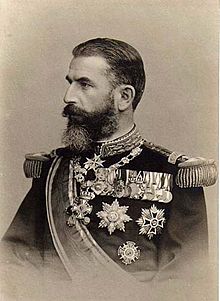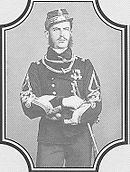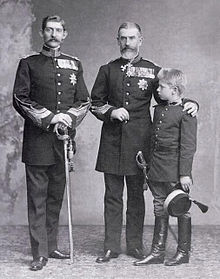- Carol I of Romania
-
Carol I 
King Carol I of Romania Domnitor, then King of Romania Reign 10 May 1866–10 October 1914 (48 years, 141 days) Coronation 22 May 1881 Predecessor Alexandru Ioan I Successor Ferdinand Spouse Elisabeth of Wied Issue Princess Maria of Romania Full name Karl Eitel Friedrich Zephyrinus Ludwig von Hohenzollern-Sigmaringen Father Prince Karl Anton of Hohenzollern-Sigmaringen Mother Princess Josephine of Baden Born 20 April 1839
Sigmaringen, GermanyDied 10 October 1914 (aged 75)
Sinaia, RomaniaBurial Curtea de Argeş, Romania Carol I (20 April 1839 – 27 September 1914 (O.S.) / 10 October 1914 (N.S.)), born Prince Karl of Hohenzollern-Sigmaringen was reigning prince and then King of Romania from 1866 to 1914. He was elected prince of Romania on 20 April 1866 following the overthrow of Alexandru Ioan Cuza by a palace coup. Following the defeat of the Ottoman Empire in the Russo-Turkish War, he was proclaimed King of Romania on 26 March 1881. He was the first ruler of the Hohenzollern-Sigmaringen dynasty, which ruled the country until the proclamation of a republic in 1947.
During his reign, he personally led Romanian troops during the Russo-Turkish War and assumed command of the Russo/Romanian army during the siege of Plevna. The country achieved full independence from the Ottoman Empire (Treaty of Berlin, 1878) and acquired the southern part of the Dobrogea (pronounced Dobruja) from Bulgaria in 1913. Domestic political life, still dominated by the country's wealthy landowning families organised around the rival Liberal and Conservative parties, was punctuated by two widespread peasant uprisings, in Wallachia (the southern half of the country) in April 1888 and in Moldavia (the northern half) in March 1907.
He married Elisabeth of Wied in Neuwied on 15 November 1869. They only had one daughter, Maria, who died aged three.
Carol's childlessness left his elder brother Leopold next in line to the throne. In October 1880 Leopold renounced his right of succession in favour of his son William, who in turn surrendered his claim six years later in favour of his younger brother, the future king Ferdinand.
Contents
Early life
Prince Karl Eitel Friedrich Zephyrinus Ludwig of Hohenzollern-Sigmaringen was born in Sigmaringen, the second son of Prince Karl Anton of Hohenzollern-Sigmaringen and his wife, Princess Josephine of Baden. After finishing his elementary studies, Karl entered the Cadet School in Münster. In 1857 he was attending the courses of the Artillery School in Berlin. Up to 1866 (when he accepted the crown of Romania) he was a Prussian officer. He took part in the Second Schleswig War, particularly at the assault of the Fredericia citadel and Dybbøl, experience which would be very useful to him later on in the Russo-Turkish war.
Although he was quite frail and not very tall, prince Karl was reported to be the perfect soldier, healthy, disciplined, and also a very good politician with liberal ideas. He was familiar with several European languages. His family being closely related to the Bonaparte family (one of his grandmothers was a Beauharnais, Joséphine's niece-in-law, and the other a Murat, Joachim's niece Marie Antoinette Murat), they enjoyed very good relations with Napoleon III of France. Romania was, at the time, under the influence of French culture and Napoleon's recommendation of Prince Karl of Hohenzollern-Sigmaringen weighed heavy in the eyes of Romanian politicians of the time, as did his blood relation to the ruling Prussian family. Ion Brătianu was the Romanian politician sent to negotiate with Karl and his family the possibility of installing Karl on the Romanian throne.
On the way to Romania
The former Romanian ruler, Alexandru Ioan Cuza, had been banished from the country by the leading noblemen and Romania was in political chaos. Cuza's double election (in Wallachia and the Moldavia) had been the basis on which Romanian unification was recognized by the European powers. With him gone, the country was in danger of dissolving.
Due to the conflict between Prussia and the Austrian Empire, Karl travelled incognito by railroad from Düsseldorf to Budapest, under the name of Karl Hettingen. From Budapest he travelled by carriage, as there was no railroad to Romania. As he walked across the border onto Romanian soil, he was met by Brătianu, who bowed before him and asked Karl to join him in a carriage.
On 10 May 1866 (22 May 1866 N.S.), Karl entered Bucharest. The news of his arrival had been transmitted through telegraph and he was welcomed by a huge crowd eager to see the new ruler. In Băneasa he was given the key to the city. That day, rain fell, ending a long period of drought – a favorable sign. As he was crowned, Karl swore this oath: "I swear to guard the laws of Romania, to maintain its rights and the integrity of its territory." He spoke the oath in French, as he did not speak Romanian.
The Constitution
Immediately after arriving in the country, the Romanian parliament adopted, on 29 June 1866, the 1866 Constitution of Romania, one of the most advanced constitutions of its time. This constitution allowed the development and modernization of the Romanian state. In a daring move, the Constitution chose to ignore the country's current dependence on the Ottoman Empire, which paved the way for Independence.
Article 82 said "The ruler's powers are hereditary, starting directly from His Majesty, prince Carol I of Hohenzollern-Sigmaringen, on male line through the right of first-born, with the exclusion of women and their issue. His Majesty's descendants will be raised in the Eastern Orthodox Religion."
After the proclamation of the Independence (1877), Romania was effectively a kingdom. From 1878, Carol held the title of Royal Highness (Alteţă Regală). On 15 March 1881, the Constitution was modified to state, among other things, that from then on the head of state would be called king, while the heir would be called prince royal. The same year he was crowned King.
The basic idea of all the royalist constitutions in Romania was that the King rules without governing.
A devoted King
King Carol was reported to be a cold person. He was permanently concerned with the prestige of the dynasty he had founded. His wife, Elizabeth, claimed he 'wore the crown in his sleep'. He was very meticulous and he tried to impose his style upon everyone that surrounded him. Though he was devoted to his job as a Romanian prince and king, he never forgot his German roots.
In 48 years of rule (the longest rule any Romanian principality has ever known), he helped Romania gain its independence, he raised its prestige, he helped redress its economy and he established a dynasty. In the Carpathian mountains, he built Peleş Castle, still one of Romania's most visited touristic attractions. The castle was built in German style, as a reminder of the king's origin. After the Russo-Turkish war, Romania gained Dobrogea and Carol ordered the first bridge over the Danube, between Feteşti and Cernavodă, linking the newly acquired province to the rest of the country.
The end of the reign
The long rule of Carol helped the quick development of the Romanian state. But, towards the end of his reign and the start of the World War I, the German-born king wanted to enter the war on the side of the Central Powers, while Romanian public opinion sided with the Triple Entente. Carol had signed a secret treaty in 1883 which had linked Romania with the Triple Alliance (1882) and although the treaty was to be activated only in case of attack from Imperial Russia towards one of the treaty's members, Carol was convinced that the honourable thing to do was to enter the war supporting the German Empire.
An emergency meeting was held with members of the government where Carol told them about the secret treaty and shared his opinion with them. The strong disagreement he faced is said to have brought on his sudden death on 10 October [O.S. 27 September] 1914. The future King Ferdinand, under the influence of his wife, Marie of Edinburgh, a British princess, was more willing to listen to public opinion.
Life and family
When he was elected prince of Romania, Carol was not married and, according to the Romanian Constitution he had approved, he was not allowed to marry a woman of Romanian origin[citation needed] . In 1869, the prince started a trip around Europe and mainly Germany, to find a bride. During this trip he met and married princess Elizabeth of Wied at Neuwied on 15 November 1869. Their marriage was one of the most unfit matches in history, with Carol being a cold and calculated man while Elizabeth was a notorious dreamer. They had one child, Princess Maria, born in 1871, who died on the 24th of March 1874. This led to the further estrangement of the royal couple, Elizabeth never completely recovering from the trauma of losing her only child.
After the proclamation of the Kingdom (1881), the succession was a very important matter of state. Since Carol's brother, Leopold, and his oldest son, William, declined their rights, the second son of Leopold, Ferdinand, was named prince of Romania and heir-presumptive to the throne. Elizabeth tried to influence the young prince into marrying her favorite lady in waiting, Elena Văcărescu. According to the Romanian constitution, though, the heir was forbidden from marrying a Romanian[citation needed] . As a result of the affair, Elizabeth was exiled for two years, till after Ferdinand's marriage to Princess Marie of Edinburgh.
Towards the end of their lives, though, Carol and Elizabeth finally found a way to understand each other and were reported to have become good friends.
Ancestors
8. Anton Aloys, Prince of Hohenzollern-Sigmaringen 4. Charles, Prince of Hohenzollern-Sigmaringen 9. Amalie Zephyrine of Salm-Kyrburg 2. Karl Anton, Prince of Hohenzollern-Sigmaringen 10. Peter Murat 5. Marie Antoinette Murat 11. Louise d'Astorg 1. Carol I of Romania 12. Karl Ludwig, Hereditary Prince of Baden 6. Karl, Grand Duke of Baden 13. Amalie of Hesse-Darmstadt 3. Josephine of Baden 14. Claude de Beauharnais, comte of Les Roches-Baritaud 7. Stéphanie de Beauharnais 15. Claude Françoise de Lezay Sources
Boris Crǎciun – "Regii şi Reginele României", Editura Porţile Orientului, Iaşi
See also
External links
 Media related to Carol I of Romania at Wikimedia Commons
Media related to Carol I of Romania at Wikimedia Commons- Royal House of Romania
- Princely House of Hohenzollern
- Princely House of Wied
- Online edition of Carol's 1899 book Reminiscences of the King of Roumania
Carol I of RomaniaCadet branch of the House of HohenzollernBorn: 20 April 1839 Died: 10 October 1914Regnal titles Preceded by
Alexandru Ioan CuzaPrince of Romania
1866–1881Became King New title King of Romania
1881–1914Succeeded by
FerdinandCategories:- 1839 births
- 1914 deaths
- People from Sigmaringen
- Field Marshals of Germany
- House of Hohenzollern-Sigmaringen
- Knights of the Garter
- Knights of the Golden Fleece
- People of the Russo-Turkish War (1877–1878)
- Roman Catholic monarchs
- Romanian Roman Catholics
- Field Marshals of Russia
- Recipients of the Order of the Black Eagle
- Recipients of the Order of Bravery
- Kings of Romania
- Burials at Curtea de Argeş Cathedral
- Princes of Hohenzollern-Sigmaringen
- Recipients of the Order of Saint George II Class
- Recipients of the Order of Saint George III Class
- Knights of the Order of the Most Holy Annunciation
Wikimedia Foundation. 2010.




